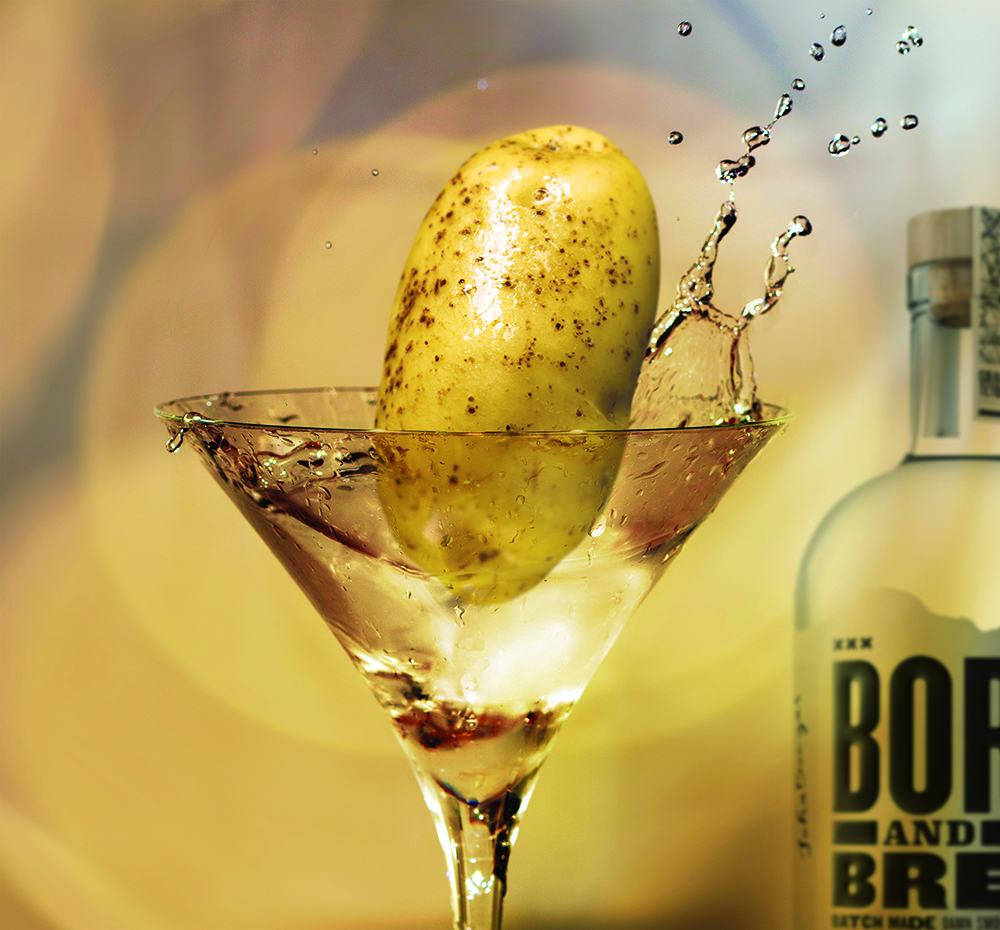Throughout the Snake River Plains of Idaho, more than 320,000 acres of potatoes are grown each year to become French fries, tater tots, or a variety of other well-loved food staples. But, some lucky potatoes will find a different calling: being poured into a White Russian, muddled into a mojito, or topped with a splash of cranberry juice. Potato vodka is quickly claiming a celebrated place in the alcohol industry, and the best-of-the-best varieties are produced in the crop’s native state: Idaho.
Vodka is made from fermenting a raw material like corn, wheat, or potatoes. The fermenting process allows added yeast to consume the sugars and create alcohol. Then, the liquid is distilled to increase the alcohol content and eventually becomes vodka when it reaches a certain proof—the percentage of alcohol to water. A typical bottle of vodka is no more than 110 proof and no less than 80 proof, or 40 percent alcohol content, as defined by the Bureau of Alcohol, Tobacco and Firearms.
The most distinguishable difference between distilling potato vodka versus grain vodka is the raw material: a vegetable versus a grain. The end result alters the texture and taste of the alcohol.
So, why potatoes? The bureau defines vodka as a “neutral spirit, without distinctive character, aroma, or taste,” but aficionados would fervently disagree, claiming noticeable differences in flavor and mouth feel, depending on the brand and materials used. Just like a fine wine or a barrel-aged whiskey, vodka connoisseurs look for certain flavor profiles. Potato vodka is known for having a richer, creamier flavor thanks to the robust sugary vegetable, while grain vodka might taste a bit fruitier or cleaner with a bigger burn down the gullet.
In Eastern Idaho’s Driggs, Grand Teton Distillery is creating coveted starchy beverages that have earned top honors from the Beverage Testing Institute. As a post-retirement business venture, founders Lee and Bill Becket bought land in the bustling ski town in 2007 with the hope of opening a hotel. But when the market sank, they changed directions to potato vodka, since Driggs is adjacent to endless farmland known for its potatoes. By 2012, Grand Teton Potato Vodka was ready to sell.
“It is earthy, buttery, and smooth,” said Andrew Boczar, the youngest son of the family-owned distillery and the head of marketing. “A lot of what makes it so great is the water we have in Teton Valley. It is very alkaline and has tons of magnesium and potassium. Water is 60 percent of your product and adds to the final flavor profile.”
Starting with potato flakes—the majority of a potato is liquid—sugar and water are added to create a soupy mash that is heated up to break apart the starches from the potato. After, the mash is placed in a fermenter with yeast and is fermented for a week. At that point, the alcohol content is about 10 to 12 percent, Boczar explained.
“We have a potato beer at this point, but we aren’t making beer.” The liquid is then placed in a pot still and distilled. After the distilling process, the brew reaches about 50 percent alcohol content.
“What comes off the pot still is not even the vodka,” Boczar said. “If we were just doing a whiskey, we would be fine.”
But vodka is even stronger than whiskey. Finally, after a final distilling to pull out more alcohol, the liquid becomes vodka at 190 proof. It is then cut with local water to become the finished product.
Nearby in the small farming town of Rigby, Distilled Resources, Inc., or DRinc, is a farm-to-bottle distillery bottling celebrated brands like Blue Ice, Teton Glacier, and 44 North. As the largest beverage alcohol distiller west of the Mississippi and the largest potato alcohol producer in North America, owner Gray Ottley and his team know their potatoes and their vodkas. Companies create their unique recipe and bring them to DRinc, which then produces the end product.
In 1988, DRinc was created to be a fuel alcohol plant under the Carter Administration’s Energy Act supporting alternative fuels. In 1992, the plant turned into a beverage producer. Potato is now the biggest raw material alcohol produced at the plant.
“The distillation equipment and technology, the Idaho russet potato, and the talent that it takes to operate the system: all three of these things combined make what we simply call a sweet and smooth potato alcohol,” said Ottley.
Ottley explained that one of the most notable qualities of the distillery is its distinguished label as farm-to-bottle, meaning everything happens within a 300-foot radius of the plant, including sourcing water from the Snake River Aquifer below, that holds more water than any of the Great Lakes. In just seven days, what once was an Idaho potato is now a happy hour favorite.
“We use 9.2 pounds of whole russet potatoes for every 750 milliliter bottle that is produced,” he said. “In 2015, we used about 10 million pounds of whole Idaho russet potatoes and 100 percent of those potatoes came from Idaho.” This distinction allows DRinc to be licensed to use “Idaho Potato” by the Idaho Potato Commission.
44 North, named after the distillery’s geographic lattitude, is one of the top selling brands out of DRinc. Owner and founder Ken Wyatt set out to create an alcohol that celebrated the flavors of the region.
“The thing that stood out to us was the idea of Idaho as a region because of the varied agricultural industry, with everything from potatoes and grains to different fruits like huckleberries,” he said. Wyatt also owns Teton Glacier vodka.
44 North’s claim to vodka fame is its Mountain Huckleberry flavor that is the perfect addition to lemonade or sipped straight. Additional vodkas like Rainier Cherry, Sunnyslope Nectarine, and pure Idaho Potato Vodka all applaud a part of Idaho’s rich landscape. But, it starts with potatoes.


